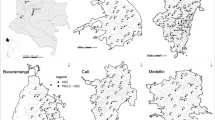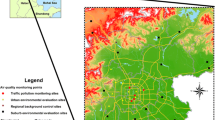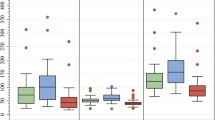Abstract
Epidemiological research requires accurate prediction of the concentrations of air pollutants. In this study, satellite-based estimates (OMI NO2), distance-weighted models (DWMs), and universal kriging (UK) are applied to land use regression (LUR) to predict annually and monthly averaged NO2 concentrations in the continental United States. In addition, to assess environmental risk, the relationship between NO2 concentrations and people potentially exposed to NO2 within urban areas is explored in 377 metropolitan statistical areas (MSAs). The results of this study show that the application of a combination of OMI NO2, UK, and DWMs to LUR yielded the highest cross-validated (CV) R2 values and the lowest root mean square error of prediction (RMSEP): 82.9% and 0.392 on a square root scale of ppb in the annual model and 70.4–83.5% and 0.408–0.518 on square root scale of ppb in the monthly models, respectively. Moreover, the model presented a spatially unbiased distribution of CV error terms. Models based on LUR provided more accurate NO2 predictions with lower RMSEP in urban areas than in rural areas. In addition, this study finds that the people living in the urban areas of MSAs, with larger populations and a higher percentage of children under 18 years of age, are likely to be exposed to higher NO2 concentrations. By contrast, people living in the urban areas of MSAs with a higher percentage of the elderly over 65 years of age are likely to be exposed to lower NO2 concentrations.










Similar content being viewed by others
References
Ash, M., & Fetter, T. R. (2004). Who lives on the wrong side of the environmental tracks? Evidence from the EPA’s risk-screening environmental indicators model. Social Science Quarterly, 85(2), 441–462.
Bechle, M. J., Millet, D. B., & Marshall, J. D. (2013). Remote sensing of exposure to NO2: satellite versus ground-based measurement in a large urban area. Atmospheric Environment, 69, 345–353.
Bechle, M. J., Millet, D. B., & Marshall, J. D. (2017). Does urban form affect urban NO2? Satellite-based evidence for more than 1200 cities. Environmental Science and Technology, 51(21), 12707–12716.
Beelen, R., Hoek, G., van den Brandt, P. A., Goldbohm, R. A., Fischer, P., Schouten, L. J., et al. (2008). Long-term effects of traffic-related air pollution on mortality in a Dutch cohort (NLCS-AIR study). Environmental Health Perspectives, 116(2), 196–202.
Beelen, R., Hoek, G., Pebesma, E., Vienneau, D., de Hoogh, K., & Briggs, D. J. (2009). Mapping of background air pollution at a fine spatial scale across the European Union. Science of the Total Environment, 407(6), 1852–1867.
Brauer, M., Lencar, C., Tamburic, L., Koehoorn, M., Demers, P., & Karr, C. (2008). A cohort study of traffic-related air pollution impacts on birth outcomes. Environmental Health Perspectives, 116(5), 680.
Briggs, D. J. (2007). The use of GIS to evaluate traffic-related pollution. Occupational and Environmental Medicine, 64, 1–2.
Briggs, D. J., Aaheim, A., Dore, C., Hoek, G., Petrakis, M., & Shaddick, G. (2005). Air pollution modelling for support to policy on health and environmental risks in Europe. APMOSPHERE Final Report.
Burrough, P. A., McDonnell, R. A., & Lloyd, C. D. (2015). Principles of geographical information systems. Oxford: Oxford University Press https://global.oup.com/academic/product/principles-of-geographical-information-systems-9780198742845?cc=us&lang=en&#. Accessed 25 Aug 2017
Castellsague, J., Sunyer, J., Sáez, M., & Antó, J. M. (1995). Short-term association between air pollution and emergency room visits for asthma in Barcelona. Thorax, 50(10), 1051–1056.
Chakraborty, J., & Zandbergen, P. A. (2007). Children at risk: measuring racial/ethnic disparities in potential exposure to air pollution at school and home. Journal of Epidemiology & Community Health, 61(12), 1074–1079.
Choubin, B., Khalighi-Sigaroodi, S., Malekian, A., & Kişi, Ö. (2016). Multiple linear regression, multi-layer perceptron network and adaptive neuro-fuzzy inference system for forecasting precipitation based on large-scale climate signals. Hydrological Sciences Journal, 61(6), 1001–1009.
Cichowicz, R., Wielgosiński, G., & Fetter, W. (2017). Dispersion of atmospheric air pollution in summer and winter season. Environmental Monitoring and Assessment, 189(12), 605.
Clark, L. P., Millet, D. B., & Marshall, J. D. (2014). National patterns in environmental injustice and inequality: outdoor NO2 air pollution in the United States. PLoS One, 9(4), e94431.
Cressie, N. (2015). Statistics for spatial data. Hoboken: Wiley https://books.google.com/books?hl=en&lr=&id=MzN_BwAAQBAJ&oi=fnd&pg=PP1&dq=Statistics+for+spatial+data&ots=NLXmy-012M&sig=NyPFZp5bQ0je7HPX-Py8IKClmCM#v=onepage&q=Statisticsforspatialdata&f=false. Accessed 1 May 2018
Downey, L., Dubois, S., Hawkins, B., & Walker, M. (2008). Environmental inequality in metropolitan America. Organization and Environment, 21(3), 270–294.
Famini, G. R., Penski, C. A., & Wilson, L. Y. (1992). Using theoretical descriptors in quantitative structure activity relationships: some physicochemical properties. Journal of Physical Organic Chemistry, 5(7), 395–408.
Filleul, L., Rondeau, V., Vandentorren, S., Le Moual, N., Cantagrel, A., Annesi-Maesano, I., et al. (2005). Twenty five year mortality and air pollution: results from the French PAARC survey. Occupational and Environmental Medicine, 62(7), 453–460.
Gauderman, W. J., Avol, E., Lurmann, F., Kuenzli, N., Gilliland, F., Peters, J., & McConnell, R. (2005). Childhood asthma and exposure to traffic and nitrogen dioxide. Epidemiology, 737–743.
Gehring, U., Heinrich, J., Krämer, U., Grote, V., Hochadel, M., Sugiri, D., … Wichmann, H.-E. (2006). Long-term exposure to ambient air pollution and cardiopulmonary mortality in women. Epidemiology (Cambridge, Mass.).
Grineski, S., Bolin, B., & Boone, C. (2007). Criteria air pollution and marginalized populations: environmental inequity in metropolitan phoenix, Arizona. Social Science Quarterly, 88(2), 535–554.
Gulliver, J., de Hoogh, K., Hansell, A., & Vienneau, D. (2013). Development and back-extrapolation of NO2 land use regression models for historic exposure assessment in Great Britain. Environmental Science & Technology, 47(14), 7804–7811.
Henderson, S. B., Beckerman, B., Jerrett, M., & Brauer, M. (2007). Application of land use regression to estimate long-term concentrations of traffic-related nitrogen oxides and fine particulate matter. Environmental Science & Technology, 41(7), 2422–2428.
Hewitt, C. N. (1991). Spatial variations in nitrogen dioxide concentrations in an urban area. Atmospheric Environment. Part B, Urban Atmosphere, 25(3), 429–434.
Hoek, G., Beelen, R., de Hoogh, K., Vienneau, D., Gulliver, J., Fischer, P., & Briggs, D. (2008). A review of land-use regression models to assess spatial variation of outdoor air pollution. Atmospheric Environment, 42(33), 7561–7578.
Hoek, G., Eeftens, M., Beelen, R., Fischer, P., Brunekreef, B., Boersma, K. F., & Veefkind, P. (2015). Satellite NO2 data improve national land use regression models for ambient NO2 in a small densely populated country. Atmospheric Environment, 105, 173–180.
Hunter, L. M., White, M. J., Little, J. S., & Sutton, J. (2003). Environmental hazards, migration, and race. Population and Environment, 25(1), 23–39.
Jerrett, M., Arain, M. A., Kanaroglou, P., Beckerman, B., Crouse, D., Gilbert, N. L., … Finkelstein, M. M. (2007). Modeling the intraurban variability of ambient traffic pollution in Toronto, Canada. Journal of Toxicology and Environmental Health - Part A: Current Issues, 70(3–4), 200–212.
Kim, J. J., Smorodinsky, S., Lipsett, M., Singer, B. C., Hodgson, A. T., & Ostro, B. (2004). Traffic-related air pollution near busy roads: the East Bay Children’s Respiratory Health Study. American Journal of Respiratory and Critical Care Medicine, 170(5), 520–526.
Kim, S. Y., Sheppard, L., & Kim, H. (2009). Health effects of long-term air pollution: influence of exposure prediction methods. Epidemiology, 442–450.
Knibbs, L. D., Hewson, M. G., Bechle, M. J., Marshall, J. D., & Barnett, A. G. (2014). A national satellite-based land-use regression model for air pollution exposure assessment in Australia. Environmental Research, 135, 204–211.
Krige, D. G. (1966). Two-dimensional weighted moving average trend surfaces for ore-evaluation. Johannesburg: South African Institute of Mining and Metallurgy.
Kumar, V. (2007). Optimal contour mapping of groundwater levels using universal kriging - a case study. Hydrological Sciences Journal, 52(5), 1038–1050.
Künzli, N., Medina, S., Kaiser, R., Quéne, P., Horak, F., Studnicka, M., et al. (2001). Assessment of deaths attributable to air pollution: should we use risk estimates based on time series or on cohort studies? American Journal Epidemiology, 153(11), 1050–1055.
McMichael, A. J., Anderson, H. R., Brunekreef, B., & Cohen, A. J. (1998). Inappropriate use of daily mortality analyses to estimate longer-term mortality effects of air pollution. International Journal of Epidemiology, 27(3), 450–453.
Meng, Z. Y., Xu, X. Bin, Wang, T., Zhang, X. Y., Yu, X. L., Wang, S. F., … An, X. Q. (2010). Ambient sulfur dioxide, nitrogen dioxide, and ammonia at ten background and rural sites in China during 2007-2008. Atmospheric Environment, 44(21–22), 2625–2631.
Mercer, L. D., Szpiro, A. A., Sheppard, L., Lindström, J., Adar, S. D., Allen, R. W., … Kaufman, J. D. (2011). Comparing universal kriging and land-use regression for predicting concentrations of gaseous oxides of nitrogen (NOx) for the Multi-Ethnic Study of Atherosclerosis and Air Pollution (MESA Air). Atmospheric Environment, 45(26), 4412–4420.
Moore, D. K., Jerrett, M., Mack, W. J., & Künzli, N. (2007). A land use regression model for predicting ambient fine particulate matter across Los Angeles, CA. Journal of Environmental Monitoring, 9(3), 246–252.
Novotny, E. V., Bechle, M. J., Millet, D. B., & Marshall, J. D. (2011). National satellite-based land-use regression: NO2 in the United States. Environmental Science & Technology, 45(10), 4407–4414.
Oakes, J. M., Anderton, D. L., & Anderson, A. B. (1996). A longitudinal analysis of environmental equity in communities with hazardous waste facilities. Social Science Research, 25(2), 125–148.
Pastor, M., Jr., Sadd, J. L., & Morello-Frosch, R. (2003). Who’s minding the kids? Pollucion, public schools, and environmental justice in Los Angeles. Social Science Quarterly, 83(1), 263–280.
Perlin, S. A., Setzer, R. W., Creason, J., & Sexton, K. (1995). Distribution of industrial air emissions by income and race in the United States: an approach using the toxic release inventory. Environmental Science & Technology, 29(1), 69–80.
Pope, C. A., III, & Dockery, D. W. (2006). Health effects of fine particulate air pollution: lines that connect. Journal of the Air and Waste Management Association, 56(6), 709–742.
Ross, Z., Jerrett, M., Ito, K., Tempalski, B., & Thurston, G. D. (2007). A land use regression for predicting fine particulate matter concentrations in the New York City region. Atmospheric Environment, 41(11), 2255–2269.
Russell, A. R., Valin, L. C., & Cohen, R. C. (2012). Trends in OMI NO2 observations over the United States: effects of emission control technology and the economic recession. Atmospheric Chemistry and Physics, 12(24), 12197–12209.
Sampson, P. D., Richards, M., Szpiro, A. A., Bergen, S., Sheppard, L., Larson, T. V., & Kaufman, J. D. (2013). A regionalized national universal kriging model using partial least squares regression for estimating annual PM2.5 concentrations in epidemiology. Atmospheric Environment, 75, 383–392.
Stieb, D. M., Judek, S., & Burnett, R. T. (2002). Meta-analysis of time-series studies of air pollution and mortality: effects of gases and particles and the influence of cause of death, age, and season. Journal of the Air and Waste Management Association, 52(4), 470–484.
Stuart, A. L., & Zeager, M. (2011). An inequality study of ambient nitrogen dioxide and traffic levels near elementary schools in the Tampa area. Journal of Environmental Management, 92(8), 1923–1930.
Su, J. G., Jerrett, M., & Beckerman, B. (2009a). A distance-decay variable selection strategy for land use regression modeling of ambient air pollution exposures. Science of the Total Environment, 407(12), 3890–3898.
Su, J. G., Jerrett, M., Beckerman, B., Wilhelm, M., Ghosh, J. K., & Ritz, B. (2009b). Predicting traffic-related air pollution in Los Angeles using a distance decay regression selection strategy. Environmental Research, 109(6), 657–670.
Su, J. G., Jerrett, M., Morello-Frosch, R., Jesdale, B. M., & Kyle, A. D. (2012). Inequalities in cumulative environmental burdens among three urbanized counties in California. Environment International, 40, 79–87.
Vedal, S. (1997). Ambient particles and health: lines that divide. Journal of the Air and Waste Management Association, 47(5), 551–581.
Vienneau, D., de Hoogh, K., & Briggs, D. (2009). A GIS-based method for modelling air pollution exposures across Europe. The Science of the Total Environment, 408(2), 255–266.
Vienneau, D., de Hoogh, K., Beelen, R., Fischer, P., Hoek, G., & Briggs, D. (2010). Comparison of land-use regression models between Great Britain and the Netherlands. Atmospheric Environment, 44(5), 688–696.
Vienneau, D., De Hoogh, K., Bechle, M. J., Beelen, R., Van Donkelaar, A., Martin, R. V., … Marshall, J. D. (2013). Western European land use regression incorporating satellite- and ground-based measurements of NO2 and PM10. Environmental Science & Technology, 47(23), 13555–13564.
World Health Organisation Europe. (2004). Health aspects of air pollution results from the WHO project “Systematic review of health aspects of air pollution in Europe.” World Health.
World Health Organization. (2018). Ambient air pollution: health impacts. http://www.who.int/airpollution/ambient/health-impacts/en/. Accessed 14 Nov 2017
Yanosky, J. D., Schwartz, J., & Suh, H. H. (2008). Associations between measures of socioeconomic position and chronic nitrogen dioxide exposure in Worcester, Massachusetts. Journal of Toxicology and Environmental Health - Part A: Current Issues, 71(24), 1593–1602.
Young, M. T., Bechle, M. J., Sampson, P. D., Szpiro, A. A., Marshall, J. D., Sheppard, L., & Kaufman, J. D. (2016). Satellite-based NO2 and model validation in a national prediction model based on universal kriging and land-use regression. Environmental Science & Technology, 50(7), 3686–3694.
Dataset
De Ferrant, J., & Hormann, C. (2014). Digital elevation data. http://viewfinderpanoramas.org/dem3.html. Accessed 25 Feb 2017
Homer, C. G., et al. (2015). Completion of the 2011 National Land Cover Database for the conterminous United States-representing a decade of land cover change information. https://www.mrlc.gov/nlcd2011.php. Accessed 15 Feb 2017
NASA Earth Observation. (2017a). Rainfall. https://neo.sci.gsfc.nasa.gov/view.php?datasetId=TRMM_3B43M. Accessed 27 Nov 2017
NASA Earth Observation. (2017b). Solar insolation. Retrieved 02/11, 2017, from https://neo.sci.gsfc.nasa.gov/view.php?datasetId=CERES_INSOL_M. Accessed 27 Nov 2017
NASA Earth Observation. (2018). Nitrogen dioxide. Retrieved 06/20, 2018, from https://neo.sci.gsfc.nasa.gov/view.php?datasetId=AURA_NO2_M.
United States Census Bureau. (2017). TIGER/Line® shapefiles and TIGER/Line® files. https://www.census.gov/geo/maps-data/data/tiger-line.html. Accessed 20 June 2018
United States Environmental Protection Agency. (2018). Air data. https://aqs.epa.gov/aqsweb/airdata/download_files.html. Accessed 20 June 2018
Funding
This work was supported by the Hongik University new faculty research support fund.
Author information
Authors and Affiliations
Corresponding author
Additional information
Publisher’s note
Springer Nature remains neutral with regard to jurisdictional claims in published maps and institutional affiliations.
Electronic supplementary material
ESM 1
(DOCX 9559 kb)
Rights and permissions
About this article
Cite this article
Lee, C., Lee, J. National NO2 exposure models for measuring its impact on vulnerable people in the US metropolitan areas. Environ Monit Assess 191, 484 (2019). https://doi.org/10.1007/s10661-019-7606-x
Received:
Accepted:
Published:
DOI: https://doi.org/10.1007/s10661-019-7606-x




